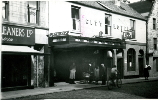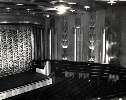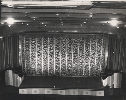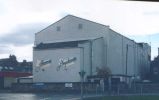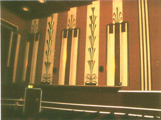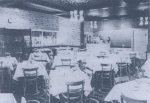High Street

The side walls featured a dark wooden dado, with horizontal banding running the full length of the stalls, up to door level. Above, a repeating pattern, mirrored on both sides, consists of conical-shell lights set between a series of illuminated vertical columns and decoration.
Caledonian Associated Cinemas & AB King The only truly Scottish-controlled cinema chain, the CAC Company was formed in 1935, with a registered address of Bank Chambers, Inverness, and the telephone number ‘Inverness 1’. It grew through merging of a number of smaller circuits and individual cinema companies, until by 1947, it controlled 51 cinemas across Scotland. One of its directors was Sir Alexander B King, who mainly handled the booking of films for them from his offices in Glasgow. AB King was also driving force behind his own circuit of over ninety cinemas across the whole of Scotland at that time; meaning he effectively controlled the booking for around 140 screens, allowing him to negotiate better deals from the film distributors, and made competing against the larger, well funded London-controlled chains such as ABC and Gaumont/Odeon much easier. In 2007, only two cinemas still show films under the CAC name: the Playhouse Perth and the Playhouse Elgin. Architect: Alister G Macdonald The architect for the Playhouse was Alister G. MacDonald. It is the earliest surviving purpose-built cinema by this important architect, one of only a handful of his buildings to survive throughout the UK, and, crucially, contains his best known surviving auditorium. MacDonald was the eldest son of Britain’s first-ever Labour Prime Minister, Ramsey MacDonald. Alister’s first cinema job was probably as Clerk of Works to Frank Verity for Paramount’s Plaza in London’s Regent Street in 1925-6. After a spell studying skyscrapers and sound insulation design in America, he went on to become the leading architect of newsreel cinemas in Britain. The skills he learned in the USA were to prove useful when it came to designing these small, compact news cinemas in cramped, awkward sites, such as railway stations. His most famous such designs were at Victoria and Waterloo Stations in London, although sadly his plans for a cinema in Glasgow's Central Station were unrealised. He also built numerous conventional cinemas, most notably for the Caledonian Associated Cinemas group (CAC) in Scotland, including the Playhouses in Peebles, Montrose [now demolished] and Elgin, the Broadway in Prestwick [due for demolition], as well as the Empire Cinema and Peace Pavilion for the Empire Exhibition in Glasgow’s Bellahouston Park in 1938 – portions of the cinema were later moved to Lochgilphead, where they survive as a guesthouse, although the Peace Pavilion has been completely lost. With offices in both Edinburgh and London, Alister Macdonald was well placed to take the latest cinema architecture trends and apply them to his designs across the country. His reputation and skills were clearly held in high regard – when the Architects Journal published a special book on Modern Cinemas in 1936, Macdonald was invited to contribute not just an examplar of his work on a ‘typical cinema’ (the Playhouse Montrose), but also an entire chapter on the design on the complexities of designing newsreel cinemas. References Architect DSA Entry Building DSA Entry The Cinemas of Alistair G MacDonald – Richard Gray Picture House (Journal of the Cinema Theatre Association), No. 19, p.30-34 Modern Cinemas - A Special Issue of the Architects Journal – Architectural Press, London, 1936. Section 2: Planning a Newsreel Cinema – Alister G MacDonald (p.7-12) Playhouse Montrose, Angus – Complete Scheme – Alister G MacDonald (p.32-33) A Brief History of Caledonian Associated Cinemas Ltd. Hornsey, Fuschiaprint, Stamford, 2004 (ISBN: 1901425983) Cinema Circuit Statistics The Scotsman: Weds 16 March 1932 (p.7) Premier's Son's Success As Architect “Mr
Alastair MacDonald, the Premier's son, is the successful architect for
a large new playhouse which is to be erected at Elgin by Elgin Picture
House Company. Mr MacDonald was in competition with leading English and
Scottish architects who specialise in picture houses, but at a meeting
of the directors which he attended yesterday his design, which
incorporated all the latest Continental ideas, was unanimously adopted.” The Scotsman: Fri 25 November 1932 (p.7) New Cinema At Elgin “A message from the Prime Minister, who was invited to the ceremony, wishing the venture success was read at the opening yesterday by Lord Provost Hamilton, of Elgin Playhouse, of which the Premier's son, Mr Alastair MacDonald, was the architect. Five hundred school children and a large number of unemployed, who were unable to obtain admission, were entertained to a free performance in Elgin Picture House, which is under the same management.” The Scotsman: Sat 31 December 1932 (p.8) Mr MacDonald Visit to Playhouse Designed by His Son “After the departure of Mr Lansbury, the Prime Minister motored to Elgin, where he paid a first visit to the new Playhouse, of which his elder son, Mr Alistair MacDonald, was architect. He was accompanied by his other son, Mr Malcolm, and by Miss Ishbel, Miss Sheila, and his private secretary. At Elgin he was joined by Professor and Mrs Edgar Collis and other friends. The party were received by Dr Alexander, the chairman of the directors, by whom they were shown over the building. They afterwards saw the film "The Silent Voice" in which George Arliss stars.”
|
